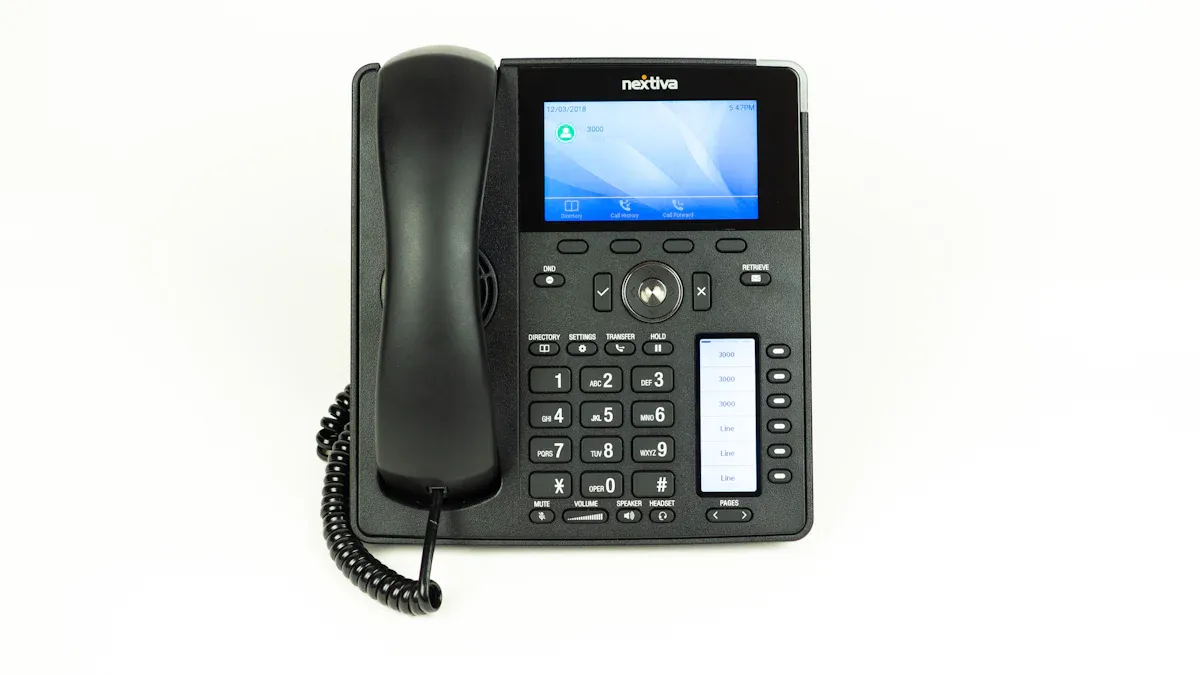
Small and medium-sized enterprises see major benefits with Telecom system VoIP IP PBX. The table below shows how these systems cut costs compared to traditional phone setups:
| Cost Component | Traditional PBX | VoIP IP PBX |
|---|---|---|
| Upfront Equipment | $5,000 – $9,000 | Mínimo |
| Software Licensing | $3,000 – $4,000 | Included |
| Installation & Setup | $1,000 – $1,500 | Up to $50 |
| Maintenance (Annual) | $3,000 – $4,000+ | Included |
| Monthly Service Fees | $1,000+ | $20 – $50 per user |
| Total Estimated Cost | $25,000 – $50,000+ | $200 – $250/month (10 users) |
Telecom system VoIP IP PBX also supports Industrial VoIP telephone, Industrial IP telephonee Industrial SIP telephone technologies, making communication secure, scalable, and reliable for modern businesses.
Top SME Communication Challenges in 2025

High Communication Costs
SMEs often struggle with high communication expenses. Traditional phone systems require significant upfront investments and ongoing maintenance. Monthly service fees can quickly add up, especially as teams grow. Many businesses look for ways to reduce these costs without sacrificing quality or reliability.
Supporting Remote and Flexible Work
Remote and flexible work have become standard for many SMEs. This shift brings new communication barriers:
- Teams rely on digital tools, which can cause miscommunication.
- Lack of face-to-face interaction makes it harder to build team cohesion.
- Different time zones complicate scheduling and coordination.
- Remote workers may feel less accountable or disconnected from company culture.
- Office staff sometimes perceive fewer opportunities for growth.
- Clear communication channels and updated management practices are essential.
Customer Service Expectations
Customer service in 2025 demands more than quick responses. Customers expect personalized and proactive support, often powered by AI. Businesses must anticipate needs and deliver tailored experiences. Outsourcing to specialized call centers has become common, allowing SMEs to access skilled professionals and advanced analytics. Data security and compliance remain top priorities.
Scalability and Growth
Growth introduces new challenges for SMEs. They must scale internal systems efficiently, often by leveraging software and automation. Key issues include:
- Skills gaps and high employee turnover.
- Training and managing larger teams.
- Adapting to supply chain disruptions.
- Investing in technology to improve customer experience and operational efficiency.
- Maintaining employee morale and connection to company goals.
Integration with Business Tools
Modern SMEs need communication systems that integrate with essential business tools. The most requested integrations include CRM platforms, e-commerce solutions, marketing automation, and unified messaging apps. These integrations help unify communication channels and support automation, making workflows more efficient.
| Tool Name | Key Integration Highlights | API Access | Implementation Time |
|---|---|---|---|
| HubSpot Marketing Hub | CRM, email, marketing automation, payment gateways | Yes | 2–4 weeks |
| Omnisend Ecommerce Automation | E-commerce, email, SMS, push notifications | Yes | 2–3 days |
| Zoho CRM | CRM, multi-channel support | Yes | 2–3 weeks |
| EngageBay | Gmail, Office 365, Zapier | Yes | N/A |
| SleekFlow | Shopify, WooCommerce, payment gateways, CRM | Yes | N/A |
| Glassix | Unified inbox, predictive analytics | Yes | N/A |
| Control Hippo | Real-time chat, video, AI tools | Yes | N/A |
Reliability and Call Quality
Reliable communication is vital for SME operations. Outages disrupt business and frustrate customers. Many SMEs now use AI-powered tools to maintain engagement during disruptions. Clear, consistent updates help build trust and reduce dissatisfaction. Regular communication reassures customers, even when issues persist.
How Telecom System VoIP IP PBX Solves SME Communication Issues

Cost Savings and Flexible Pricing
Telecom system VoIP IP PBX helps SMEs control costs with flexible pricing models. Unlike traditional PBX systems, which require large upfront investments and long-term contracts, VoIP solutions offer pay-as-you-go options. Businesses can add or remove users instantly and only pay for what they need. This approach reduces waste and prevents over-provisioning. The table below highlights the differences:
| Aspect | VoIP IP PBX Systems | Traditional PBX Systems |
|---|---|---|
| Setup Costs | Typically no setup or installation fees | High upfront costs for hardware and installation |
| Pricing Model | Monthly fee per user, usage-based pricing available | Fixed costs, often with long-term contracts |
| Scalability | Easily scalable by adding/removing users instantly | Limited scalability, requires physical changes |
| Maintenance Costs | Included in service, cloud-hosted | On-site maintenance required, additional costs |
| Payment Flexibility | Monthly or annual payments with possible discounts | Less flexible, fixed contract terms |
| Infrastructure | Cloud-based, no physical hardware needed | On-premise hardware investment |
This pricing flexibility allows SMEs to manage budgets more effectively and scale communications as their business grows.
Remote Work and Secure Access
Telecom system VoIP IP PBX supports remote work by providing secure and reliable access for employees anywhere. Hosted PBX systems use centralized cloud management, making it easy for remote workers to connect. Security features include encryption, multi-factor authentication, and built-in VPN support. These tools protect business conversations and keep sensitive data safe.
- Hosted PBX systems offer secure cloud management.
- Encryption and multi-factor authentication protect calls and messages.
- Mobile-optimized systems allow secure communication on smartphones and tablets.
- Automatic updates keep security strong without extra effort.
- Unified communications tools combine voice, video, and messaging with built-in security.
Employees can use computers, IP phones, or mobile devices to stay connected. Features like voicemail, call forwarding, and extension dialing help remote teams work smoothly. Integration with business tools such as CRM and project management platforms improves efficiency for teams working from different locations.
Advanced Customer Service Features
Telecom system VoIP IP PBX gives SMEs access to advanced customer service tools. These features help businesses respond faster and improve customer satisfaction.
- Unified communications bring together voice, messaging, and email.
- Advanced call routing sends calls to the right person or department.
- Auto attendants act as virtual receptionists, greeting callers and guiding them.
- Voicemail greetings and transcriptions make it easy to review messages.
- AI-driven analytics provide insights to improve service.
- CRM integration unifies customer data for personalized support.
- Multi-device support lets staff answer calls from anywhere.
- Online dashboards allow easy management of phone numbers and call logs.
These features reduce wait times and ensure customers reach the right person quickly. Real-time feedback tools help managers address issues fast and coach staff on the spot. Businesses can offer 24/7 support, personalized interactions, and versatile services like appointment scheduling and troubleshooting. This approach builds trust and keeps customers loyal.
Effortless Scalability for Growing SMEs
Telecom system VoIP IP PBX makes it easy for SMEs to scale their communication systems. Adding new lines or users takes just a few clicks, with no need for extra hardware or technician visits. This flexibility supports rapid growth and changing business needs.
- Minimal hardware required for setup.
- Quick addition or removal of users.
- No costly installations or physical wiring.
- Advanced features like call forwarding, voicemail to email, and video conferencing included.
- Global reach allows calls from anywhere, supporting remote and international teams.
Cloud-hosted solutions handle updates and maintenance, reducing the workload for IT staff. SMEs can deploy new features or expand capacity without overspending. This scalability helps businesses stay agile and competitive.
Seamless Integration with Business Applications
Telecom system VoIP IP PBX integrates smoothly with essential business applications. This integration improves workflow efficiency and reduces manual work.
- Centralizes customer data from all applications.
- Eliminates manual data entry and reduces errors.
- Supports real-time reporting for faster decision-making.
- Automates tasks like invoicing and record updates.
- Ensures new tools connect easily as the business grows.
For example, syncing customer data between a CRM and an email marketing platform saves time and prevents mistakes. Integration also enables targeted communication, improving the customer experience and freeing employees to focus on important tasks.
Reliable, High-Quality Communication
Telecom system VoIP IP PBX delivers reliable and clear communication, even during busy times. Modern VoIP systems use advanced technology to ensure high call quality and system dependability.
- Quality of Service (QoS) settings prioritize voice traffic to reduce delays and packet loss.
- Monitoring tools track network performance and call quality.
- Redundancy measures, like backup internet connections, improve uptime.
- Support for multiple concurrent calls ensures the system handles peak usage.
- Call center features like queuing and distribution manage high call volumes.
- Integration with business software improves call routing and reduces handling times.
Modern VoIP systems often provide better audio quality than traditional PBX systems. Regular updates and strong security measures protect against disruptions. SMEs benefit from stable, high-quality communication that supports business growth and customer satisfaction.
Telecom system VoIP IP PBX helps SMEs grow and adapt in 2025.
- Businesses save money and reduce setup costs.
- Teams work from anywhere with reliable tools.
- Advanced features boost productivity and customer service.
- Quick scaling supports business changes.
This system prepares companies for future communication needs.
FAQ

What makes Joiwo’s C200 ideal for SMEs in 2025?
Joiwo’s C200 offers easy setup, flexible scaling, and advanced features. SMEs can manage calls, support remote teams, and keep costs low.
How does the C200 protect business communications?
The C200 uses a built-in VPN, encryption, and secure access controls. These features help keep calls and data safe from unauthorized access.
Can the C200 integrate with existing business software?
Yes. The C200 supports integration with CRM, email, and other business tools. This helps teams work faster and reduces manual tasks.


